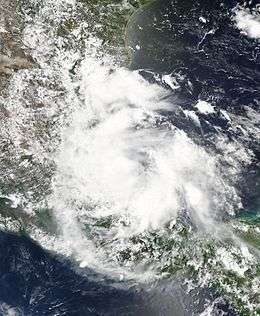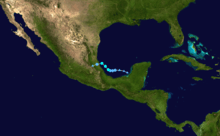Tropical Storm Danielle (2016)
| Tropical storm (SSHWS/NWS) | |
 Tropical Storm Danielle nearing landfall in Mexico on June 20 | |
| Formed | June 19, 2016 |
|---|---|
| Dissipated | June 21, 2016 |
| Highest winds |
1-minute sustained: 45 mph (75 km/h) |
| Lowest pressure | 1007 mbar (hPa); 29.74 inHg |
| Fatalities | 1 confirmed |
| Damage | Minimal |
| Areas affected | Mexico, Veracruz |
| Part of the 2016 Atlantic hurricane season | |
Tropical Storm Danielle was the earliest fourth named Atlantic storm on record, about three days earlier than Tropical Storm Debby in 2012. A relatively weak and somewhat ragged tropical cyclone, Danielle was the fourth tropical cyclone of the 2016 Atlantic hurricane season. It formed from a tropical wave that had exited off the coast of Africa on June 8. It moved across the Atlantic, where unfavourable conditions initially prevented development, until it entered the Bay of Campeche on June 18, at which point it developed into a tropical storm. Danielle later made landfall on June 20 as a minimal tropical storm and soon dissipated thereafter. Damage was minimal, however one person died from flooding.
Meteorological history

The precursor to Danielle can be tracked back to a tropical wave that moved off the African coast on June 8. It remained disorganised due to unfavourable conditions and was not expected to develop in the short term. The wave moved across the Atlantic, eventually moving across northern South America by June 13. Once moving into the southwestern Caribbean Sea by June 15, thunderstorm activity increased and it subsequently moved over the Yucatan Peninsula by June 17. Development of the system began as it moved over the Bay of Campeche. On June 19; an area of low pressure formed to the north of Ciudad del Carmen, Mexico, and after gaining enough organisation and thunderstorm activity, it was declared a tropical depression by 12:00 UTC.[1]
The depression moved slowly to the west under the influence of a mid-level ridge of high pressure that was stationed over the southern United States. By June 20, it strengthened into a tropical storm, at which it was assigned the name Danielle. The storm also simultaneously reached its peak intensity of 45 mph (72 km/h) and a pressure of 1,007 millibars (29.7 inHg). Afterwards, Danielle turned to the west-southwest and made landfall near Tamiahua, Mexico as a minimal tropical storm. Danielle then rapidly weakened and it dissipated over Mexico the following day.[1]
Preparations and impact
Mexico
A tropical storm warning was issued from the coast of Mexico from Laguna Verde to Rio Paranuco. It was later discontinued when Danielle moved ashore and rapidly weakened.[1] Danielle dropped heavy rainfall across the affected regions, particularly the areas near Veracruz and Tamiahua. Official amounts were not reported, however the maximum rainfall that was observed was around 6.22 inches (15.8 cm) at Cosaultán de Carvajal. The cyclone also brought high winds along with it, with a maximum wind gust of up to 45 mph (72 km/h) reported near Tampico.[1]
Across much of Veracruz, officials suspended school activities and the Port of Veracruz was temporarily closed. Flooding in the Pueblo Viejo Municipality affected 1,200 families and prompted activation of public shelters.[2] One person, a homeless guy, died in Ciudad Madero, Tamaulipas after he drowned in a storm drain when flash flooding struck the area he was in caused by the heavy rains of Danielle.[3]
See also
- Other storms of the same name
- Timeline of the 2016 Atlantic hurricane season
- Tropical Storm Bret (2005)
- Tropical Storm Barry (2013)
References
- 1 2 3 4 "Tropical Storm Danielle" (PDF). National Hurricane Center. Retrieved 8 November 2016.
- ↑ "Reportan daños por tormenta Danielle en Veracruz" (in Spanish). Veracruz, Mexico: e-consulta Veracruz. June 20, 2016. Retrieved June 21, 2016.
- ↑ "Tormenta Danielle causa un muerto en México". El Nuevo Dia (in Spanish). Mexico City, Mexico. June 21, 2016. Retrieved June 22, 2016.
